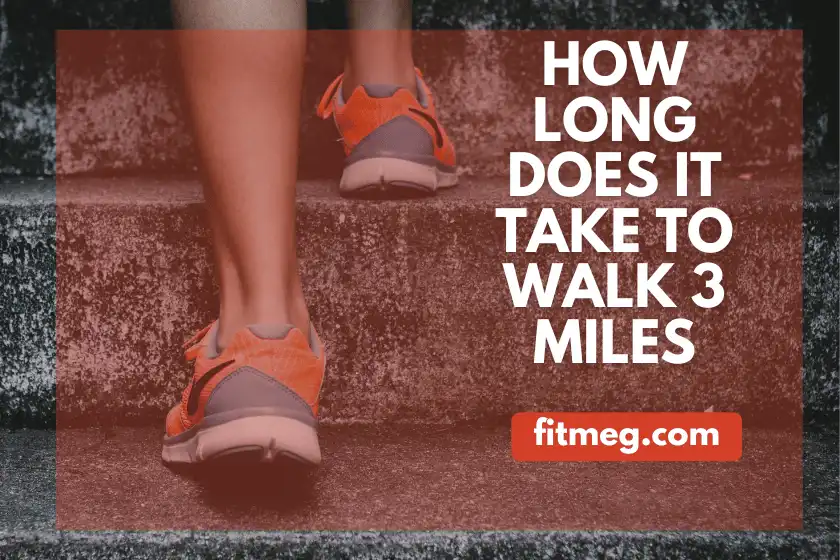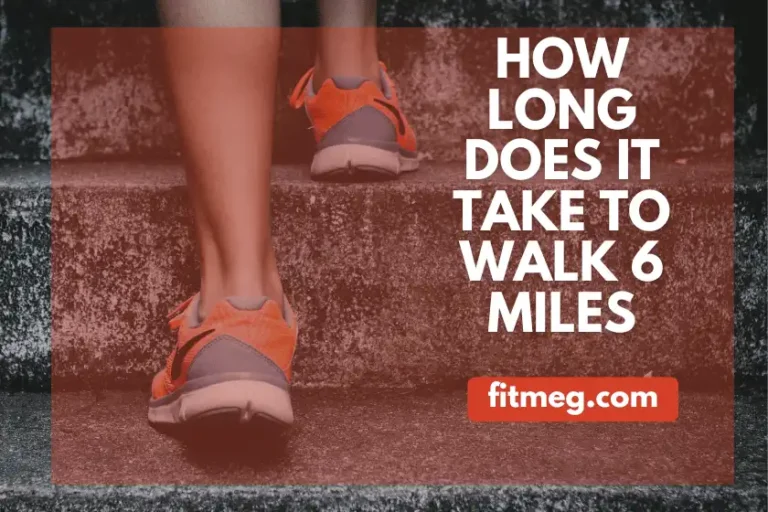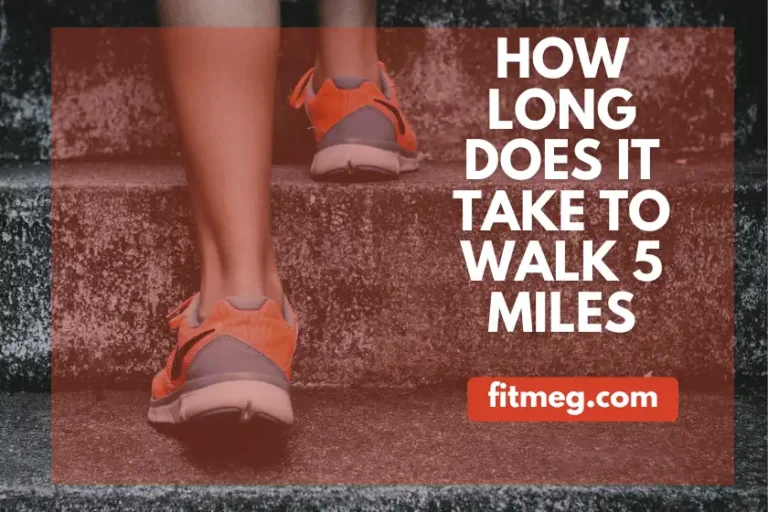How Long Does It Take To Walk 3 Miles By Age and Pace

Walking is one of the simplest yet most beneficial forms of exercise. It requires no equipment, can be done anywhere, and provides immense health benefits. But to reap these benefits, you need to walk enough distance and for enough time. Many fitness experts recommend walking 3 miles as a suitable target for most people. But how long does it take to walk 3 miles?
This comprehensive guide provides a detailed breakdown of the time needed based on factors like age, gender, fitness level, walking pace, terrain, treadmill vs outside, calorie burn, technique, weather and more. Follow our structured advice to accurately estimate your personal 3 mile walking time and learn tips to improve it.
Understanding The 3 Miles
Walking just 3 miles most days of the week can significantly boost your cardiovascular health, strengthen muscles, improve weight loss, and extend lifespan. To make walking 3 miles easy to fit into your daily routine, it’s important to know how long this distance takes for different individuals based on age, fitness level, and walking pace. We provide all the key details you need below.
First, let’s define the 3 miles distance in steps and different units.
How Many Steps in 3 Miles?
We can also convert 3 miles into steps, based on the average stride length. Stride lengths range around 2-3 feet on average. At a 2.5 foot stride length, it would take approximately 6,300 steps to walk 3 miles. At a 3 foot stride, around 5,300 steps. Use a pedometer while walking to get your exact stride length and steps for 3 miles.
How Long 3 Miles into Different Units
To visualize the distance another way, 3 miles equals:
| Unit | Distance |
|---|---|
| Kilometers | 4.83 |
| Meters | 4,828 |
| Feet | 15,840 |
| Yards | 5,280 |
| Inches | 190,080 |
| Centimeters | 482,803 |
| Millimeters | 4,828,032 |
| Nautical Miles | 2.6 |
No matter which units you prefer, walking this distance provides outstanding health dividends.
Also Read:- How Long Does It Take To Walk 5 Miles By Age And Pace?
How Long Does It Take to Walk 3 Miles by Age and Pace?
Your walking pace typically slows gradually as you age, increasing the time it takes to cover 3 miles. Fitness level also plays a key role. Below we provide tables estimating walking times for 3 miles based on age and pace for men and women.
Estimated 3 Mile Walk Times for Men by Age And Pace
| Age Group | 2mph | 3mph | 4mph | 5mph |
|---|---|---|---|---|
| 20-29 years | 1 hr 30 min | 1 hr | 45 min | 36 min |
| 30-39 years | 1 hr 40 min | 1 hr 5 min | 50 min | 40 min |
| 40-49 years | 1 hr 40 min | 1 hr 5 min | 50 min | 40 min |
| 50-59 years | 1 hr 45 min | 1 hr 10 min | 52 min | 42 min |
| 60+ years | 1 hr 50 min | 1 hr 15 min | 55 min | 44 min |
Estimated 3 Mile Walk Times for Women by Age And Pace
| Age Group | 2mph | 3mph | 4mph | 5mph |
|---|---|---|---|---|
| 20-29 years | 1 hr 30 min | 1 hr | 45 min | 36 min |
| 30-39 years | 1 hr 45 min | 1 hr 10 min | 52 min | 42 min |
| 40-49 years | 1 hr 45 min | 1 hr 15 min | 55 min | 44 min |
| 50-59 years | 1 hr 50 min | 1 hr 20 min | 1 hr | 48 min |
| 60+ years | 1 hr 55 min | 1 hr 25 min | 1 hr 5 min | 52 min |
Note:- These tables are calculated based on the average walking speeds by age group and the formula for calculating time, which is distance divided by speed
These estimates demonstrate why knowing your natural walking pace is key to predicting how long it will take you to finish 3 miles. Cool weather, hills, or fatigue can slow any walker’s pace.
How Long to Walk 3 Miles in Different Terrain?
The type of terrain you’re walking on can significantly impact your pacing and how long it takes to cover 3 miles. Here’s how different surfaces affect time:
| Terrain | Pace Impact (%) | Average Pace (mph) | Estimated Time |
|---|---|---|---|
| Flat | 0% | 3.0 | 100 min |
| Uphill | -50% | 1.5 | 200 min |
| Downhill | +20% | 3.6 | 83 min |
| Rugged | -60% | 1.2 | 250 min |
Flat Terrain: Walking on flat and even surfaces, such as paved roads or sidewalks, generally allows for a faster walking speed. On a flat surface, individuals can walk at around 3 mph.
Uphill Terrain: Walking uphill requires more effort as you are working against gravity. A steep incline of 10 to 20 percent forces you to take smaller steps. You’ll expend more effort and take longer to reach your destination.
Downhill Terrain: Conversely, walking downhill can increase your walking speed as you’re working with gravity. However, caution is required to maintain balance and prevent falls.
Rugged Terrain: Walking on rugged terrain like trails or uneven surfaces can significantly slow down your pace. A 1.5 to 2 mph pace on rugged terrain is the most realistic.
You’ll always walk 3 miles fastest on smooth, flat pavement compared to rougher or uneven terrain. Allow 10-15% more time if tackling lots of hills or trails.
Please note that these are approximate values and can vary based on individual fitness levels and specific conditions of the terrain. Always ensure to wear appropriate footwear and take necessary precautions when walking in different terrains.
How Long Does it Take to Walk 3 Miles on a Treadmill?
Can you match your outdoor walking times on a treadmill? Treadmills do make pacing easier due to the moving belt doing some of the work. Most treadmills show the distance covered, so you can directly compare your 3 mile time. Here are some tips for matching outdoor times:
- Set incline to 1% to account for lack of wind resistance.
- Adjust speed periodically to keep effort level consistent.
- Exceed outdoor pace first 5 minutes until adjusting to the belt.
- Focus on perceived exertion, not just matching speed.
With these adjustments, you should be able to replicate your outdoor walking times fairly closely on a treadmill. Use the machine’s programs to add intervals or hills as well.
Also Read: How Long Does It Take To Walk 6 Miles By Age and Pace?
How Long Does It Take To Walk 3 Miles At A Brisk Pace
- A brisk walking pace is generally considered to be 3-4 mph. This is faster than an average or leisurely walking speed.
- For most healthy adults, walking 3 miles at a brisk pace of 4 mph takes approximately 45 minutes.
- At an even faster brisk pace of 5 mph, 3 miles would take around 36 minutes.
- Factors like fitness level, age, terrain, and weather conditions can impact brisk walking time for 3 miles. Fit younger walkers may be able to briskly walk 3 miles in 30-40 minutes.
- Brisk walking provides more health and fitness benefits than leisurely walking, as it raises your heart rate more significantly and burns more calories.
- To briskly walk 3 miles, focus on taking quick, energized steps with good posture and arm drive. Powering your arms and legs can help maintain a brisk pace.
- Starting gradually and building up duration and intensity is key if new to brisk walking. This prevents injury. Aim to briskly walk 3 miles at least 3 days per week for fitness.
- Tracking brisk 3 mile walk times can help you monitor your improving fitness when combined with other training. Always allow rest and recovery after brisk walking to rebuild muscles.
Calories Burned While Walking 3 Miles
Walking 3 miles at a moderate pace of 3-4 mph burns significant calories, aiding weight loss and maintenance. Here are estimates for calories burned per 3 mile walk:
| Weight (lbs) | Speed (mph) | Calories Burned |
|---|---|---|
| 125 | 2 | 150 |
| 125 | 3 | 195 |
| 125 | 4 | 225 |
| 155 | 2 | 186 |
| 155 | 3 | 232 |
| 155 | 4 | 281 |
| 185 | 2 | 222 |
| 185 | 3 | 279 |
| 185 | 4 | 335 |
On average, an adult may burn between 180 and 300 calories walking 3 miles at a moderate speed of 3 to 4 miles per hour. However, these values are estimates and the actual number of calories burned can vary. For a more accurate estimate, consider using a pedometer with a calorie counter or a fitness tracker.
Factors like body weight, walking speed, hills and added resistance impact calories burned. But consistently walking 3 miles most days can help most people maintain a calorie deficit for gradual weight loss over time.
Other Factors Affecting the Time to Walk 3 Miles
Many additional factors beyond your age and fitness level can influence how long it takes to walk 3 miles. Be aware of these other elements:
- Body weight – Extra pounds require more energy to move.
- Walking technique – Proper form and posture optimize efficiency.
- Wind resistance – Strong headwinds slow pace and increase time.
- Temperature and humidity – Heat and humidity impair endurance.
- Purpose – Leisurely stroll vs focused power walking impact pace and time.
- Clothing and shoes – Lighter, breathable clothing and proper shoes assist quicker pace.
- Nutrition and hydration – Eating and drinking adequately fuels the walk.
- Sidewalks vs trails – Smoother sidewalks allow faster pace than natural trails.
- Time of day – Most people walk slowest early morning and fastest late afternoon.
Being cognizant of these additional factors can help explain day-to-day variations in your 3 mile walking times. Focus on proper preparation to optimize your pace.
Health Benefits of Walking 3 Miles Daily
- Improves cardiovascular health – Regular 3 mile walks keep your heart and lungs strong.
- Assists weight control – Walking 3 miles burns around 300-400 calories for most people.
- Strengthens leg muscles and bones – The impact during 3 mile walks builds lower body strength.
- Enhances mood – The exercise and outdoor exposure boosts mood through endorphin release.
- Lowers blood pressure – Studies show regular walking helps reduce hypertension.
- Reduces risk of chronic disease – Consistent walking helps prevent diabetes, heart disease, and stroke.
- Supports joint health – The motion lubricates joints and keeps them flexible.
- Increases energy levels – Better circulation oxygenates muscles to energize them.
Tips for Starting a 3 Mile Walking Routine
- Get comfortable shoes designed for walking to avoid injury.
- Build up gradually from 1 mile to 3 miles over several weeks.
- Walk at a moderate pace you can maintain for the full distance.
- Schedule your walk for the same time daily to build a habit.
- Mix up your walking routes to add variety.
- Invite a friend to walk with you for motivation.
- Use a fitness app or pedometer to track distance.
- Maintain good posture and arm swing technique.
- Do dynamic stretches before and after walking.
- Allow rest days as needed to let your body recover.
Conclusion
We hope this guide provided you a comprehensive overview of how long it takes to walk 3 miles based on all the key factors that can influence your pace and time. The best way to precisely determine your personal 3 mile walking time is to choose a typical route and time yourself periodically under different conditions. Compare your times to the averages provided based on your age and pace. With a little practice, you’ll know exactly how long it takes you. You can then schedule your 3 mile walks confidently into your daily or weekly routine to reap the immense health and fitness benefits.
Frequently Asked Questions (FAQs)
Q) Is walking 3 miles tiring?
A) Walking 3 miles is generally not too tiring for most healthy adults. At a moderate pace, 3 miles can be walked in 45-60 minutes and should not be overly strenuous. However, factors like fitness level, terrain, walking speed, and energy levels can impact how tiring it feels. Those new to regular exercise may find walking 3 miles challenging at first.
Q) How long to walk 3 miles?
A) It typically takes most people 45-60 minutes to walk 3 miles at a moderate pace of 3-4 mph. At a brisk walking pace of 4-5 mph, it takes around 30-45 minutes for most people to walk 3 miles. Times vary based on fitness level, terrain, walking pace, and other factors.
Q) Can you walk 3 miles in 1 hour?
A) Yes, most people can walk 3 miles in one hour at a moderate walking pace of 3-4 mph. This equates to 20-25 minutes per mile or a speed of 3-4 mph, which is a typical casual walking pace for many. Fit walkers may be able to walk 3 miles in an hour at an even faster pace.
Q) How many minutes does it take to walk 3 miles?
A) For most people, it takes about 45-60 minutes to walk 3 miles at a moderate pace. At a brisk walking pace, it takes around 30-45 minutes to walk 3 miles for most healthy adults. Times vary based on factors like fitness level, walking speed, terrain, and more.
Q) Will I lose weight if I walk 3 miles a day?
A) Yes, walking 3 miles per day can contribute to weight loss over time. Walking burns calories and creates a calorie deficit which leads to weight loss. For a 200 pound person, walking 3 miles burns around 300 calories. Done consistently as part of an overall healthy lifestyle, walking 3 miles daily will help shed excess weight.






